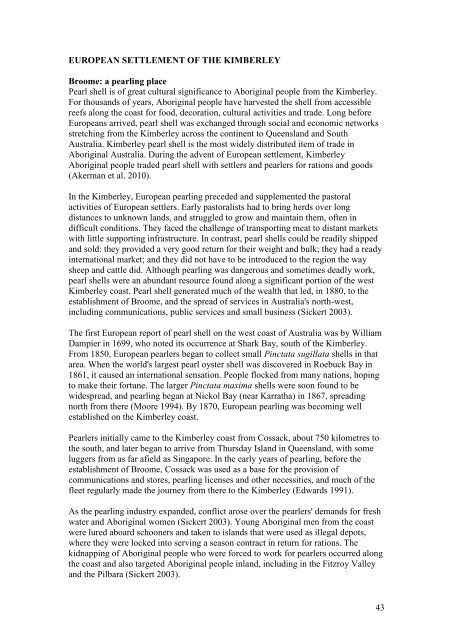WEST KIMBERLEY PLACE REPORT - Department of Sustainability ...
WEST KIMBERLEY PLACE REPORT - Department of Sustainability ...
WEST KIMBERLEY PLACE REPORT - Department of Sustainability ...
Create successful ePaper yourself
Turn your PDF publications into a flip-book with our unique Google optimized e-Paper software.
EUROPEAN SETTLEMENT OF THE <strong>KIMBERLEY</strong><br />
Broome: a pearling place<br />
Pearl shell is <strong>of</strong> great cultural significance to Aboriginal people from the Kimberley.<br />
For thousands <strong>of</strong> years, Aboriginal people have harvested the shell from accessible<br />
reefs along the coast for food, decoration, cultural activities and trade. Long before<br />
Europeans arrived, pearl shell was exchanged through social and economic networks<br />
stretching from the Kimberley across the continent to Queensland and South<br />
Australia. Kimberley pearl shell is the most widely distributed item <strong>of</strong> trade in<br />
Aboriginal Australia. During the advent <strong>of</strong> European settlement, Kimberley<br />
Aboriginal people traded pearl shell with settlers and pearlers for rations and goods<br />
(Akerman et al. 2010).<br />
In the Kimberley, European pearling preceded and supplemented the pastoral<br />
activities <strong>of</strong> European settlers. Early pastoralists had to bring herds over long<br />
distances to unknown lands, and struggled to grow and maintain them, <strong>of</strong>ten in<br />
difficult conditions. They faced the challenge <strong>of</strong> transporting meat to distant markets<br />
with little supporting infrastructure. In contrast, pearl shells could be readily shipped<br />
and sold: they provided a very good return for their weight and bulk; they had a ready<br />
international market; and they did not have to be introduced to the region the way<br />
sheep and cattle did. Although pearling was dangerous and sometimes deadly work,<br />
pearl shells were an abundant resource found along a significant portion <strong>of</strong> the west<br />
Kimberley coast. Pearl shell generated much <strong>of</strong> the wealth that led, in 1880, to the<br />
establishment <strong>of</strong> Broome, and the spread <strong>of</strong> services in Australia's north-west,<br />
including communications, public services and small business (Sickert 2003).<br />
The first European report <strong>of</strong> pearl shell on the west coast <strong>of</strong> Australia was by William<br />
Dampier in 1699, who noted its occurrence at Shark Bay, south <strong>of</strong> the Kimberley.<br />
From 1850, European pearlers began to collect small Pinctata sugillata shells in that<br />
area. When the world's largest pearl oyster shell was discovered in Roebuck Bay in<br />
1861, it caused an international sensation. People flocked from many nations, hoping<br />
to make their fortune. The larger Pinctata maxima shells were soon found to be<br />
widespread, and pearling began at Nickol Bay (near Karratha) in 1867, spreading<br />
north from there (Moore 1994). By 1870, European pearling was becoming well<br />
established on the Kimberley coast.<br />
Pearlers initially came to the Kimberley coast from Cossack, about 750 kilometres to<br />
the south, and later began to arrive from Thursday Island in Queensland, with some<br />
luggers from as far afield as Singapore. In the early years <strong>of</strong> pearling, before the<br />
establishment <strong>of</strong> Broome, Cossack was used as a base for the provision <strong>of</strong><br />
communications and stores, pearling licenses and other necessities, and much <strong>of</strong> the<br />
fleet regularly made the journey from there to the Kimberley (Edwards 1991).<br />
As the pearling industry expanded, conflict arose over the pearlers' demands for fresh<br />
water and Aboriginal women (Sickert 2003). Young Aboriginal men from the coast<br />
were lured aboard schooners and taken to islands that were used as illegal depots,<br />
where they were locked into serving a season contract in return for rations. The<br />
kidnapping <strong>of</strong> Aboriginal people who were forced to work for pearlers occurred along<br />
the coast and also targeted Aboriginal people inland, including in the Fitzroy Valley<br />
and the Pilbara (Sickert 2003).<br />
43
















